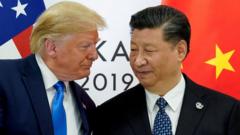As America reassesses its defense commitments, the future of the multi-billion dollar Aukus submarine pact remains uncertain.
**US Reevaluating Aukus Submarine Pact Amidst America First Policy**

**US Reevaluating Aukus Submarine Pact Amidst America First Policy**
The US reviews its submarine deal with Australia and the UK under the Aukus agreement, emphasizing an “America First” approach.
The United States has initiated a review of its substantial submarine agreement with Australia and the UK, aligning the evaluation with the "America First" policy of the current administration. The Aukus arrangement, aimed at countering China's rising influence, facilitates Australia’s acquisition of its inaugural nuclear-powered submarines from the US, alongside a collaborative effort to create a new fleet through advanced technology sharing.
Both Australia and the UK have portrayed the review as a customary process for new administrations, particularly since the Aukus pact was signed in 2021 when all three nations had differing leadership. The contract, valued at approximately £176 billion ($239 billion; A$368 billion), faces mounting scrutiny amidst rising expectations from the Biden administration for enhanced military expenditure from allies.
The review is being led by Elbridge Colby, a former critic of the Aukus agreement, who previously questioned the rationale behind transferring critical military technology at a time of high need for US resources. In response, Australia's Defence Minister Richard Marles expressed confidence that the deal would progress, emphasizing Australia's necessity for a long-range submarine capability.
While Australia has indicated its willingness to increase defense spending, it has refrained from fully meeting the US's proposed requirement of 3.5% of GDP on defense investments. The UK has committed to reaching 2.5% by 2028, with a further increase to occur in subsequent years.
Comments from analysts suggest the US may examine whether Australia intends to employ the submarines in a manner consistent with American strategic interests, especially regarding potential tensions around Taiwan. There is speculation that the focus of the accord might pivot from submarine provision to bolstering other long-range weapon technologies.
Observers opine that if the US were to withdraw from the deal, it would potentially bolster China's stance, given their past criticism of the Aukus arrangement. Nevertheless, the deal presents Australia with a significant enhancement of its military capabilities, allowing it to operate advanced nuclear submarines, which will provide greater operational reach compared to its current fleet.
Under the latest iteration of the agreement, the US and UK plan to position a limited number of nuclear submarines in Western Australia starting from 2027. Australia will also acquire three used Virginia-class submarines, with provisions for two additional vessels in the 2030s, while a novel nuclear submarine design is slated to be constructed collaboratively by the UK and Australia, utilizing advanced technology from all three nations.
The overarching Aukus pact is viewed by many as a crucial strategic alliance, supporting regional stability in the Indo-Pacific and beyond, despite facing criticism from China regarding potential escalations in armament and conflicts.
Both Australia and the UK have portrayed the review as a customary process for new administrations, particularly since the Aukus pact was signed in 2021 when all three nations had differing leadership. The contract, valued at approximately £176 billion ($239 billion; A$368 billion), faces mounting scrutiny amidst rising expectations from the Biden administration for enhanced military expenditure from allies.
The review is being led by Elbridge Colby, a former critic of the Aukus agreement, who previously questioned the rationale behind transferring critical military technology at a time of high need for US resources. In response, Australia's Defence Minister Richard Marles expressed confidence that the deal would progress, emphasizing Australia's necessity for a long-range submarine capability.
While Australia has indicated its willingness to increase defense spending, it has refrained from fully meeting the US's proposed requirement of 3.5% of GDP on defense investments. The UK has committed to reaching 2.5% by 2028, with a further increase to occur in subsequent years.
Comments from analysts suggest the US may examine whether Australia intends to employ the submarines in a manner consistent with American strategic interests, especially regarding potential tensions around Taiwan. There is speculation that the focus of the accord might pivot from submarine provision to bolstering other long-range weapon technologies.
Observers opine that if the US were to withdraw from the deal, it would potentially bolster China's stance, given their past criticism of the Aukus arrangement. Nevertheless, the deal presents Australia with a significant enhancement of its military capabilities, allowing it to operate advanced nuclear submarines, which will provide greater operational reach compared to its current fleet.
Under the latest iteration of the agreement, the US and UK plan to position a limited number of nuclear submarines in Western Australia starting from 2027. Australia will also acquire three used Virginia-class submarines, with provisions for two additional vessels in the 2030s, while a novel nuclear submarine design is slated to be constructed collaboratively by the UK and Australia, utilizing advanced technology from all three nations.
The overarching Aukus pact is viewed by many as a crucial strategic alliance, supporting regional stability in the Indo-Pacific and beyond, despite facing criticism from China regarding potential escalations in armament and conflicts.






















